EXAM 2 332 wk 6 and 7 executive function;;;; 332 wk 7 and 8 Interactions in Long-Term Memory;;;; 332 wk 9 and 10 Learning EXAM 2 review, 332 wk 11 and 12 reasoning and decision making
1/202
There's no tags or description
Looks like no tags are added yet.
Name | Mastery | Learn | Test | Matching | Spaced |
|---|
No study sessions yet.
203 Terms
// Executive functioning and the Prefrontal cortex
•Researchers have found various evidence linking Executive Functioning with the prefrontal cortex (Miller & Cohen, 2001).
•Executive Functioning (or Cognitive control): A collection of cognitive processes which include planning, cognitive flexibility, abstract thinking, understanding rules, initiating appropriate actions, inhibiting inappropriate actions, and selecting relevant sensory information.
•
Executive Functioning (or Cognitive control) // Executive functioning and the Prefrontal cortex
A collection of cognitive processes which include planning, cognitive flexibility, abstract thinking, understanding rules, initiating appropriate actions, inhibiting inappropriate actions, and selecting relevant sensory information.
Phineas Gage (1848 Railroad construction accident)
Rail spike that went through head and damaged his left prefrontal lobe
// led to him having issues with his planning and scheduling; acting differently among others.
// Development and maturation of the Prefrontal cortex
•Neural connections towards the prefrontal cortex mature until the early 20's. Therefore, adolescents may still rely on their emotional, impulsive urges. (Luna, Thulborn, Munoz, Merriam, Garver, Minshew, , et al., 2001).
// Miyake and Friedman's theory of executive functions (1999)
•There are three aspects of executive functions:
•Updating: the continuous monitoring and quick addition or deletion of contents within one’s working memory.
•Inhibition: one's capacity to supersede (replace) responses that are immediate in a given situation.
•Shifting: one's cognitive flexibility to switch between different tasks or mental states.
Updating // Miyake and Friedman's theory of executive functions (1999)
the continuous monitoring and quick addition or deletion of contents within one's working memory.
Inhibition // Miyake and Friedman's theory of executive functions (1999)
one's capacity to supersede (replace) responses that are immediate in a given situation.
Shifting // Miyake and Friedman's theory of executive functions (1999)
one's cognitive flexibility to switch between different tasks or mental states.
// (theoretical executive functioning framework) "3 aspects"
•A cornerstone of this theoretical executive functioning framework is the understanding the individual differences in executive functions, yet they are all still related to each other.
// Freewill vs. Volition (Benjamin Libet et al. 1983)
•A participant is asked sit at a desk with a button to press.
•EEG electrodes were attached to the participant’s scalp in order to measure brain activity.
•Participants were instructed to carry out some small, simple motor activity, such as pressing a button, within a certain time frame. No limits were placed on the number of times the subject could perform the action within this period.
•During the experiment, the subject would be asked to note when "he or she was first aware of the wish or urge“ to press the button and then decide when to consciously press the button.
•On average, approximately 200 milliseconds elapsed between the first appearance of conscious “urge” to press the button and the free will of actually pressing the button.
•Surprisingly, Libet and fellow researchers (1983) discovered that brain activity started 300 milliseconds BEFORE the conscious awareness of the wish or urge to act of pressing a button.
•Libet's (1983) experiment suggests that unconscious processes in the brain are the true initiator of actions, and conscious free will therefore plays no part in generating actions. Free will is regarded as an epiphenomenon.
•In contrast, Libet argues that volition (faculty or power of using one's will) represents the executive control (i.e. veto power) over the unconscious processes that are already activated in the brain.
// Self-control Capacity
•Roy Baumeister and fellow researchers (Baumeister, Bratslavsky, Muraven, & Tice, 1998; Vohs & Heatherton, 2000) have developed a strength model of self-control.
•A major assumption of the model is that engaging in acts of self-control draws from a limited “reservoir” of self-control that, when depleted, results in reduced capacity for further self-regulation.
•In the theoretical model, self-control is viewed as analogous to a muscle that requires strength and energy to exert force over a period of time.
•It can become fatigued after a period of sustained exertion and have reduced capacity to exert self-control over an extended period of time, which Baumeister and fellow researchers have called a state of ego depletion.
ego depletion // Self-control Capacity
fatigued after a period of sustained exertion and have reduced capacity to exert self-control over an extended period of time.
// Inducing Ego depletion
•Empirical tests of the ego-depletion effect have typically adopted an experimental procedure using two unrelated self-control tasks, known as the dual-task paradigm (Baumeister et al.,1998; Finkel et al., 2006; Muraven, Tice, & Baumeister, 1998).
•Participants assigned to an experimental ego-depletion group are required to engage in two consecutive tasks requiring self-control (i.e. monitoring a response).
•Control participants are also required to engage in two consecutive tasks, but only the second task requires self-control.
•Ego depletion has also been induced by creating a situation where people have to suppress their emotions (e.x. watching a video about a leg injury)
// Measurement of Ego Depletion
•Persistence solving puzzles or working on problems (Scheichel, Vohs, and Baumeister, 2003)
•Cold pressor test (measure of pain tolerance) (Schmeichel and Vohs, 2009)
// Criticisms of Ego Depletion Theory
•A replication study by Sripada, Kessler, and Jonides (2014) with 2141 participants carried out at two dozen labs across the world using an specified ego-depletion method and protocol failed to find any evidence for ego depletion.
•Moreover, a meta analysis of over 100 previously published studies on the topic of ego depletion by Carter and McCullough (2015) found that the effect size estimate was small (d = .2) and not significantly different from zero.
// Information processing approach to memory (flow of information)
// Information processing approach to memory (flow of information) END
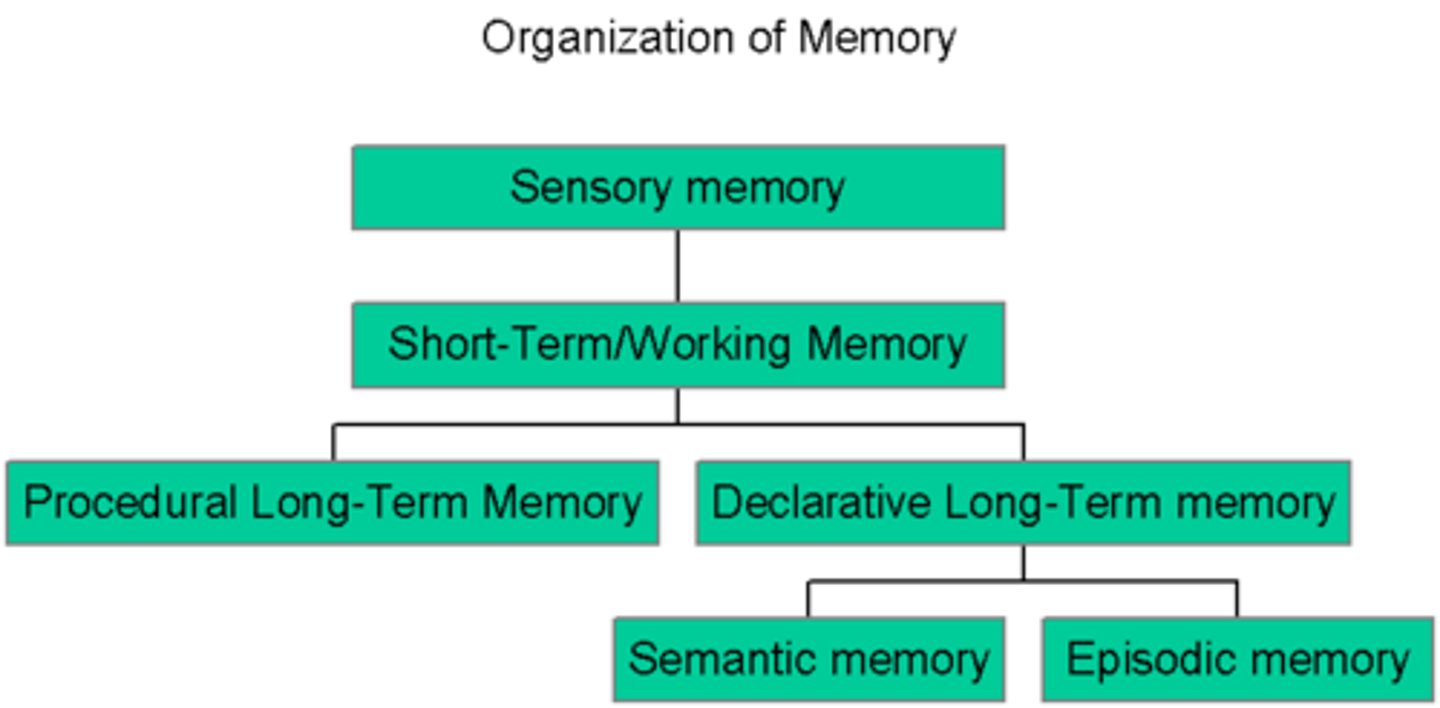
Implicit memory // Evaluating Long Term memory
unconscious retention of information or events that can affect current thoughts and actions. This can be measured through priming, and relearning.
Explicit memory // Evaluating Long Term memory
conscious and intentional recollection of event or memory. Measured through recall and recognition.
Procedural memories // Components of Long Term memory
memory for performing a task, action, skill. "knowing how." This is a form of implicit memory.
Declarative memories // Components of Long Term memory
memory for facts, rules, concepts and events. "knowing what/that." This is a form of explicit memory.
-Some declarative memories can be transformed into procedural memories via automaticity (Anderson, 1983) (ex. driving a car, speaking in another language)
Semantic memory // Types of Declarative Memory
memory of general knowledge. Facts and rules about the world.
// sky is blue, grass is green.
Episodic memory // Types of Declarative Memory
autobiographical memories of events experienced by a person and the context of how these events occurred. This includes flashbulb memories.
// Semantic Long-Term Memory
// Investigating Semantic Memory: Sentence Verification task
•Sentences appear on a screen one at a time and participants must quickly judge if the sentences are True or False.
•Reaction time and error rates are the measure of performance.
•This taps at explicit, controlled cognitive processes.
•Demonstration: In the next few slides, you will read statements (Just read them to yourself).
•Once you have understood the sentence, shout aloud your answer as quickly and as accurately (Yes or No) as possible.
// What do we know about the organization and the processes within Semantic Memory?
•Memory is a hierarchical network of concepts

Semantic Network //// What do we know about the organization and the processes within Semantic Memory?
an interrelated set of concepts or body of knowledge.
Node //// What do we know about the organization and the processes within Semantic Memory?
a point or location in the network representing a concept, property, or feature.
Proposition //// What do we know about the organization and the processes within Semantic Memory?
the relationship between two concepts
Cognitive economy //// What do we know about the organization and the processes within Semantic Memory?
only non-redundant facts are stored in memory
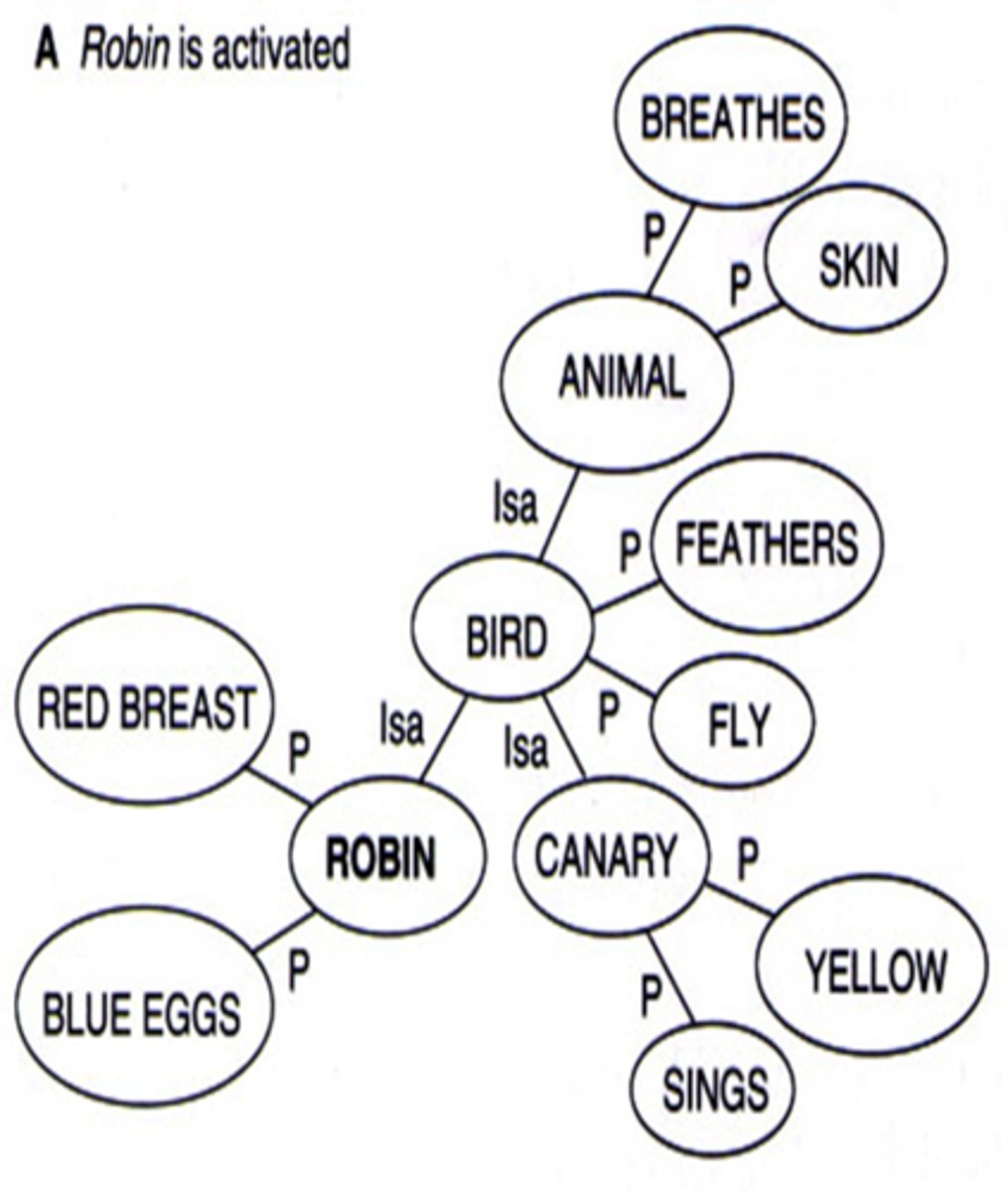
Inheritance //// What do we know about the organization and the processes within Semantic Memory?
members of a category possess or inherit the properties of the category itself
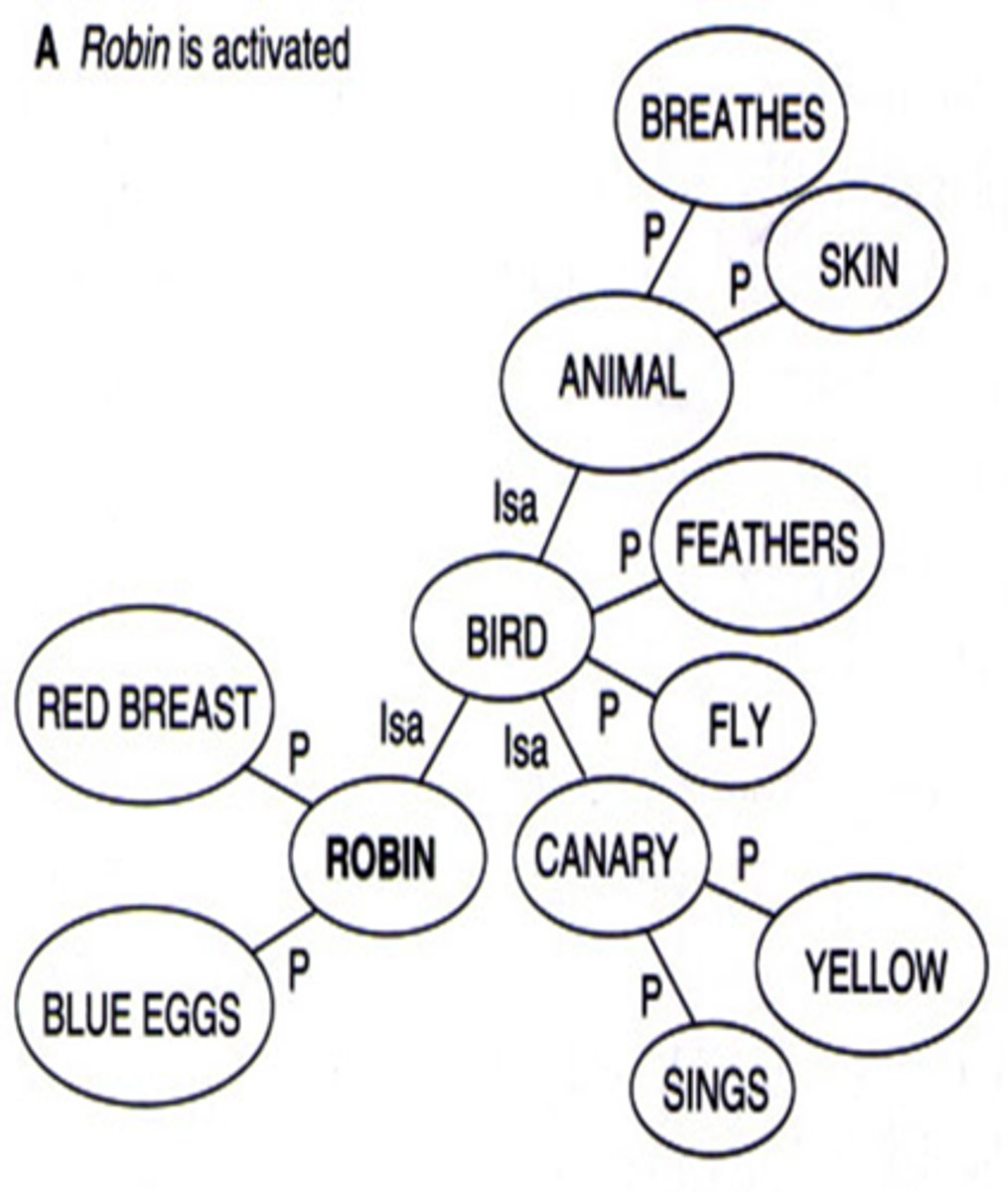
// Reaction times increase based on the distance of nodes on a semantic network
reaction times
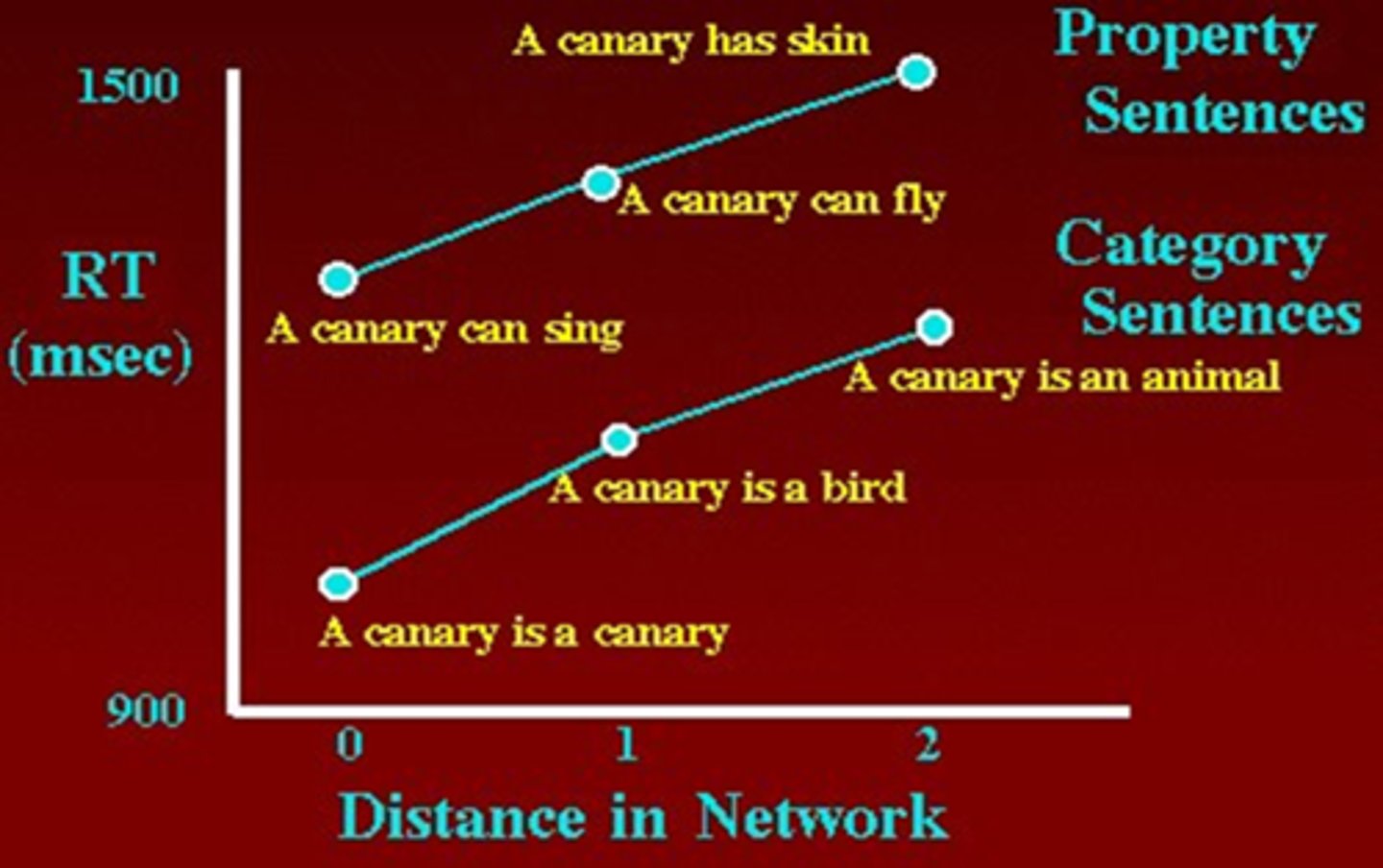
// Representational Assumptions
•Propositional representation of meaning: The meaning of a concept is based on its category membership, properties and features.
•Propositional Representation reflects the arbitrary nature of labels upon objects and concepts in the world where people live. Meaning is not tied to a sensory modality (vision, hearing, words etc.)
•People require a propositional representation to have a common ground upon which they are referring to objects and concepts in the world.
//// •In the context of a propositional representation,
-(a)visual imagery is like a description,
-(b)there is a sequential representation, and
-(c)there are explicit representation of relations between concepts.
Propositional representation of meaning
the meaning of a concept is based on its category membership, properties and features.
// "agreement of a collection of features like a dictionary."
// Propositional Representation
•In the context of a propositional representation,
-(a)visual imagery is like a description,
-(b)there is a sequential representation, and
-(c)there are explicit representation of relations between concepts.

// Analogical Representation
•Analogical representation of meaning: The meaning of a concept is based on its parallel representations in the real/outside world and the semantic network within the mind.
•There is a one-to-one representation between an object in the world and the mental representation in the semantic network.
•In the context of an analogical representation,
•(a) visual mental imagery is like visual perception,
•(b) there is a parallel representation, and
•(c) there are implicit representations of relations between concepts.
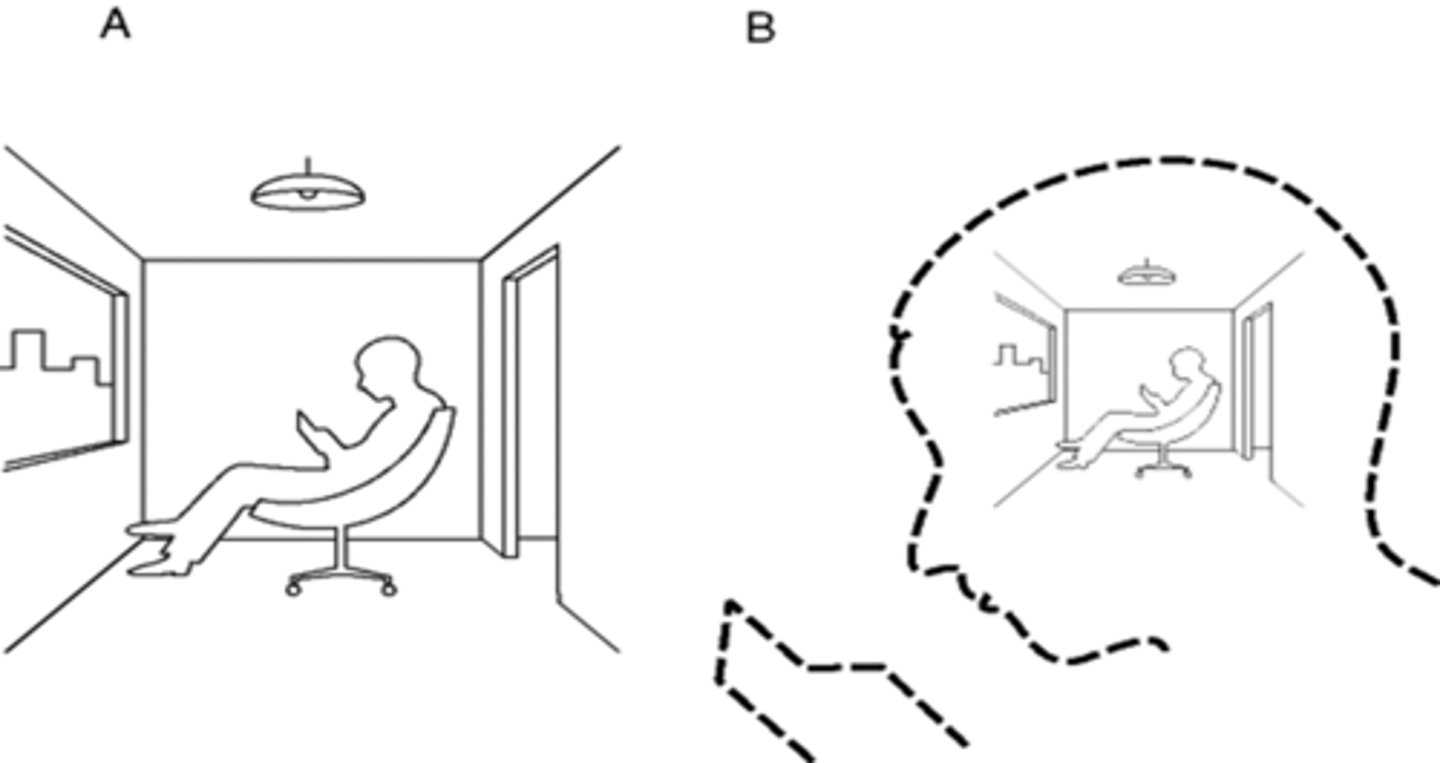
Analogical representation of meaning
the meaning of a concept is based on its parallel representations in the real/outside world and the semantic network within the mind.
// "must exist in the world"
Semantic Relatedness
•The distance between two nodes in a network is determined by relation or similarity. Concepts close in meaning or highly related
(e.g., doctor, nurse) are stored close together in memory, while unrelated concepts (doctor, truck) are stored far away
•This is developed over time and dependent on experience.
(Category of Women, Fire and Dangerous things by Aborigines (George Lakoff, 1990))
Typicality Effects
more typical members of a category are judged faster than are less typical ones.
• “A dove is a bird” is verified faster than is “A chicken is a bird.”
• "A whale is a fish." (high similarity but false)
• "A penguin is a bird." (low similarity but true)
Exemplar // Explanation of Typicality Effects: Exemplar vs. Prototype
there is a specific example or instance that serves as the most typical member of a category. Members of a category are compared on how close they are with the exemplar.
(Brooks, 1978; Estes, 1986; Hintzman, 1986; Medin & Schaffer, 1978; Nosofsky, 1986)
•Exemplar patient suffering from depression
// "observed one characteristic"
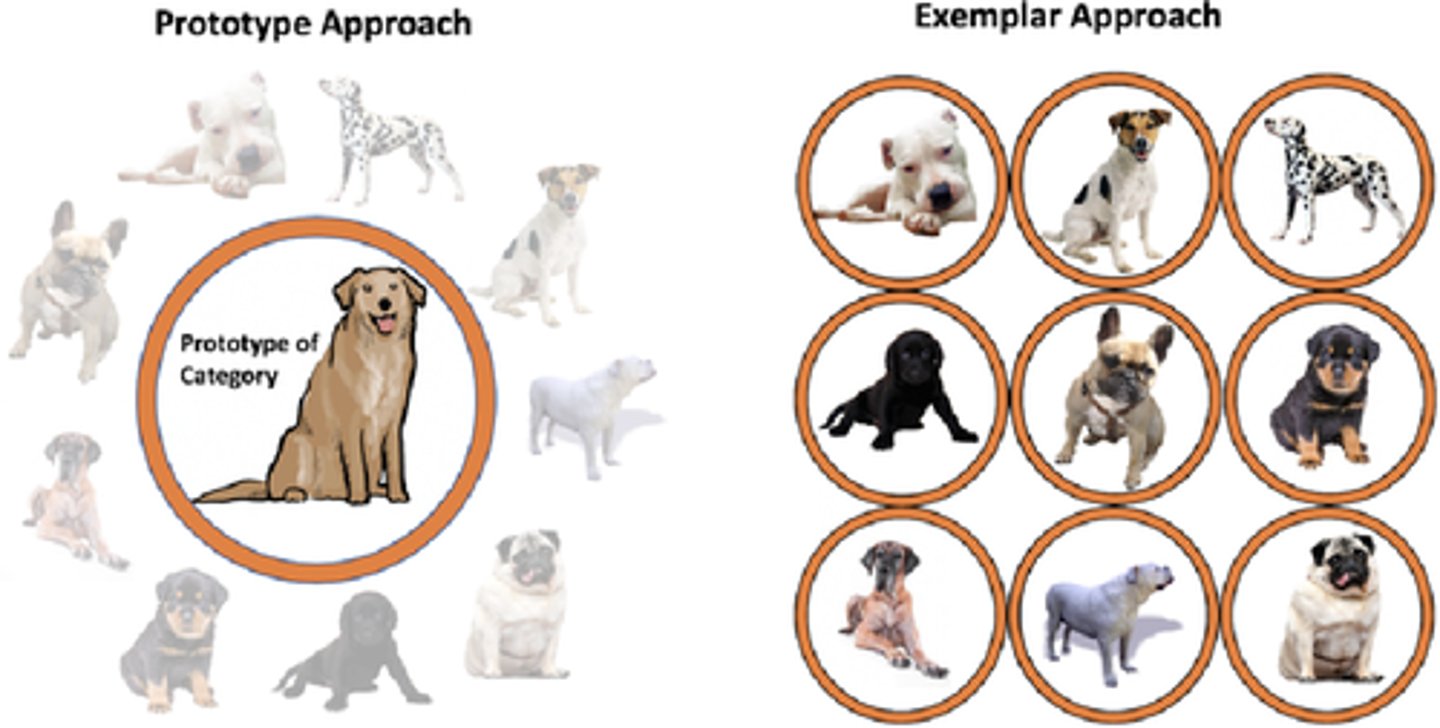
Prototype // Explanation of Typicality Effects: Exemplar vs. Prototype
there is a hypothetical concept that is composed on the "averaged" features between the various members of a category. This is based upon a propositional representation.
(Posner & Keele, 1968, 1970; Reed, 1972).
•Prototype symptoms of a patient suffering from depression.
// "check all characteristics"
// "In this prototype theory, any given concept in any given language has a real world example that best represents this concept."
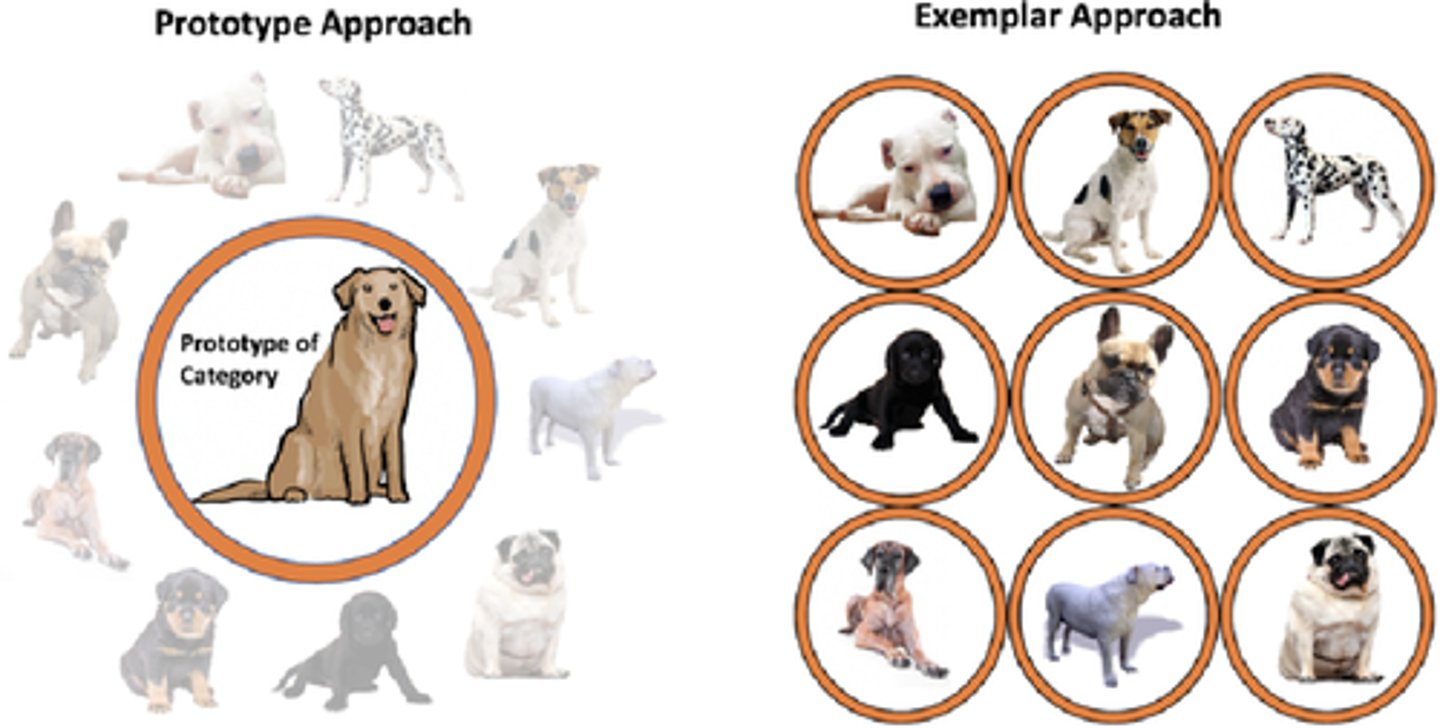
Spreading Activation // Processing assumption of a semantic network
•The mental activity of access and retrieval involving information being activated across a region of the semantic network.
•Passive concepts are activated and made available in working memory.
•Activation spreads to related and neighboring nodes and information.
•There can be multiple cycles of activation within a semantic network. (i.e. reactivation of a concept or information)
•(Example: the game of Taboo ® involves spreading activation of distant nodes to activate a target word)

Availability // Availability vs. Accessibility
the memory trace exists and encoded into LTM. This is dependent on the initial encoding by STM/WM.
Accessibility // Availability vs. Accessibility
degree to which the memory trace can be retrieved from the network. This is dependent on the structure of the semantic network and the amount of spreading activation through the network.
// Availability vs. Accessibility
•Freud's slips of the tongue in relation to priming.
•Priming for racial categories.
// Implicit Memory in Dissociative Fugue (Lyon, 1985)
•Jane Doe was discovered by the police. She was disheveled, and wandering.
•She reported no previous memory nor identity.
•During a clinical evaluation, Jane Doe was shown a phone and asked to randomly call a number. The clinician found out that the number Jane Doe called was to her mother
// "called her mother unconsiously"
Anterograde Amnesia // Amnesia
the inability to store new long-term memories that occurs after an amnesia inducing event.
// Interaction between episodic and semantic memory
•The normal, everyday operation of long term memory involves the continual, coordinated, cooperative processes of interaction between semantic and episodic memories.
•Reproductive memory: A highly accurate, verbatum (word-forward) exact recording/experience of an event.
•Reconstructive memory: Remembering by combining elements of experience with existing knowledge.
•People are generally good in recalling or recognizing the meaning or content of what was experienced (the gist) but not the exact experience (the details).
Reproductive memory // Interaction between episodic and semantic memory
A highly accurate, verbatum (word-forward) exact recording/experience of an event.
Reconstructive memory // Interaction between episodic and semantic memory
Remembering by combining elements of experience with existing knowledge.
// Schemas and Scripts
•Schema: an organized, structured set of information about a concept, theme or person.
•Schemas involves categorization of any type of information in the world (hospital, shopping mall, mother, conflict, acceptance, secure, abuse, failure).
•Scripts (Schank & Abelson, 1977): schemas for a events in the world.
•(ex. Restaurant script, Grocery shopping script, Daily routine script, TV watching script)
•Inference: The process by which a person draws connections between concepts, determines referents and derives conclusions. (assumption, fill-in-the gaps)
Schema // Schemas and Scripts
an organized, structured set of information about a concept, theme or person.
•Schemas involves categorization of any type of information in the world (hospital, shopping mall, mother, conflict, acceptance, secure, abuse, failure).
Scripts // Schemas and Scripts
(Schank & Abelson, 1977): schemas for a events in the world.
•(ex. Restaurant script, Grocery shopping script, Daily routine script, TV watching script)
Inference // Schemas and Scripts
The process by which a person draws connections between concepts, determines referents and derives conclusions. (assumption, fill-in-the gaps)
// Evidence for Schemas (Brewer & Treyens, 1981)
•Subjects were asked to wait in an office and they were later asked to recall the various objects from the room.
•Subjects showed good memory for objects consistent with an office (ex. A stapler), but they had poor memory for objects inconsistent with an office (ex. A toy top) and showed false memory for objects consistent with an office (ex. paper clips)
// Evidence for Scripts (Bower, Black & Turner, 1979)
•Participants were asked to read stories based on common themes (Ex. Going to the doctors office, eating at a restaurant).
•Afterwards, participants were asked to recall the events in the story.
•Participants were better recalling script-inconsistent actions (talking with the chef) than script-consistent actions (paying the bill). (novelty)
•Participants also showed that they falsely recalled and recognized script-consistent actions that were never explicitly stated in the stories.
// Pichert and Anderson (1977)
•People can implicitly use prior knowledge to interpret ambiguous events and the corresponding bias is revealed during the time of memory recall.
•Pitchert and Anderson (1977) instructed participants to read through a scenario describing a floor-plan of a house from the perspective of a home-buyer vs. burglar.
•Researchers found that participants instructed to have a home-buyer perspective recalled information related to the features of the house that make it a good investment. In contrast, participants given the burglar perspective recalled information related to being able to steal from the house.

// The DRM False Memory Task (Deese, 1959, Roediger & McDermott, 1995)
•Related to the priming of information in a semantic network.
•Source Misattribution: The inability to distinguish whether the original event or some later event was the source of the information.
Source Misattribution // The DRM False Memory Task (Deese, 1959, Roediger & McDermott, 1995)
The inability to distinguish whether the original event or some later event was the source of the information.
// Leading Questions and Memory Distortions (Loftus & Palmer, 1974); Elizabeth Loftus "Car Crash" Memory Study;
•Subjects saw a film of a car accident
•Later, different subjects were asked:
•How fast were the cars going when they:
smashed?, collided?, bumped?, contacted?
•Subjects estimates of speed varied with the verb they got in the question phase of the experiment.
(smashed > collided > bumped > contacted)
fastest estimate slowest estimate

// Factors involved in the overconfidence in eyewitness memory (Wells, Olson, & Charman, 2002)
•Increased exposure to the associated information to the incident or event.
•Post-identification reinforcement (by other people, police etc.)
•Repeated questioning of the eyewitness.
// Storebeck and Clore (2005) Classical music; Emotions and False Memories
•Storbeck and Clore (2005) used a Deese-Roediger-McDermott false memory task to examine how emotional states influence processing styles.
•Researchers primed a positive (uplifting classical music) or negative mood (downtrodden classical music) or no mood at all (control group) among the participants before the false memory task was presented.
•In the first part of the study (Experiment 1), the researchers demonstrated that the negative mood group recalled fewer critical lures compared to both the positive and control groups.
// Follow up experiment (positive memory increases false memory)
•A follow-up experiment asked whether the effect observed in Experiment 1 was due to encoding processes or strategies.
•To examine this question, the researchers asked participants to write down both words they recalled as having been presented and words that came to mind but that had not been presented.
•Overall, the sad mood group recorded fewer total critical lures compared to the positive mood group.
•This suggests that negative emotion had reduced critical lure activation during encoding and positive affect increases false memories.
Autobiographical Memory // Reproductive memory
The study of one's lifetime collection of personal memories.
// Reproductive memory
•Autobiographical Memory: The study of one’s lifetime collection of personal memories.
•Flashbulb Memories: Extremely vivid recollections of emotional memories of particular events. especially when the events were surprising or highly unusual.
•(Note: Flashbulb memories may also be vulnerable to Source Misattribution and forgetting, but people still report being confident about the accuracy of the memory.)
Flashbulb Memories // Reproductive memory
Extremely vivid recollections of emotional memories of particular events. especially when the events were surprising or highly unusual.
•(Note: Flashbulb memories may also be vulnerable to Source Misattribution and forgetting, but people still report being confident about the accuracy of the memory.)
// Hirst et al (2009) report
•Hirst et al (2009) report an extensive study for the memory of 9/11 events involving 3000 individuals from 7 American cities.
•Surveys were conducted 1 week after the attack, 11 months later, and 35 months later.
•The researchers found significant evidence for forgetting, but inconsistent with the amount of normal forgetting that people experience in their daily lives.
•A detailed analysis of the type of the factual details remembered shows variations in the accuracy of flashbulb memories. For example, people’s memory for the crash sites was significantly higher than the names of the airlines.

// Memory for Negative words
•Ochsner & Schacter (2000) found that normal people tend to remember negative words (ex. sad, die, gun) from a free recall list due the detailed, specific emotional recollections they felt during the time the negative words were encountered.
•Mineka & Nugent (1995) found that depressed individuals tend to remember more negative words than positive words from a free recall list and this fits in with their negative-self schema.
•When recalling autobiographical events, people in positive moods, compared with those in negative moods, describe such events using more abstract, global representations (Beukeboom & Semin, 2005, 2006).
// The Brain and Declarative Memory
•The hippocampus is necessary for the formation of new explicit (Semantic and Episodic) long-term memories. It helps organize the distributed representation regarding a memory from the different areas of the brain (vision, smell, hearing, touch, taste, emotion)
•Damage to the hippocampus causes an inability to form new explicit declarative (semantic and episodic) memories; Anterograde Amnesia (ex. Patient EP and HM)
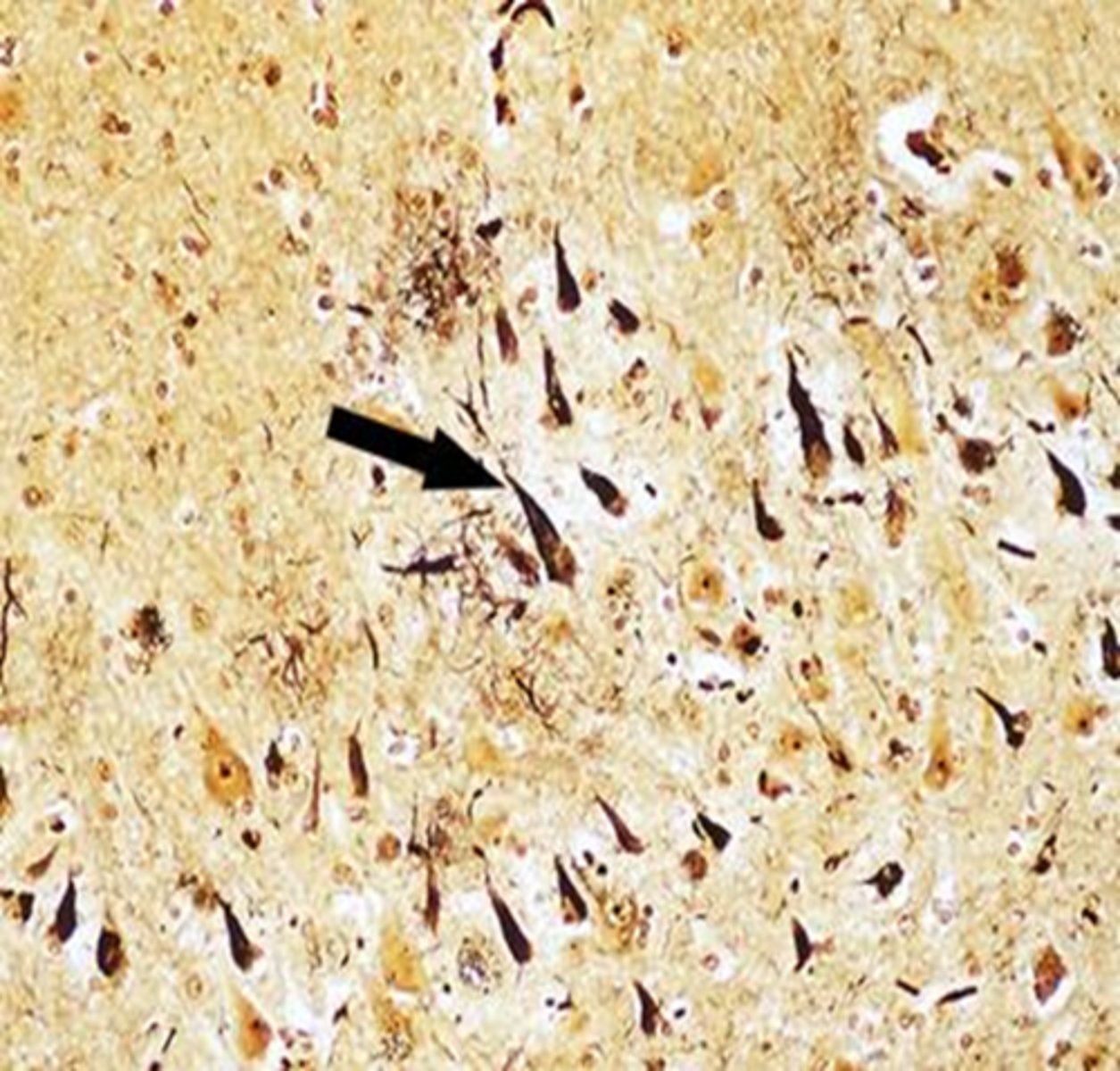
// Theories of hippocampal function
•Cognitive map theory: constructs maps of the world based on the relationships between external landmarks and objects
•Evidence: Place cells in rat hippocampi were activated when a rat is placed in a specific location, but only after the rat becomes familiar with that location.
•Configural association theory: the hippocampus organizes and retains the behavioral significance of combinations of stimuli and the context that they are presented in, but not the individual stimuli themselves.
Cognitive map theory // Theories of hippocampal function
constructs maps of the world based on the relationships between external landmarks and objects
•Evidence: Place cells in rat hippocampi were activated when a rat is placed in a specific location, but only after the rat becomes familiar with that location.
Configural association theory // Theories of hippocampal function
the hippocampus organizes and retains the behavioral significance of combinations of stimuli and the context that they are presented in, but not the individual stimuli themselves
// Long-Term Potentiation (LTP)
•Long-term increase in the excitability of a postsynaptic neuron to a particular presynaptic input caused by repeated, intense, high frequency activity from that presynaptic input. In other words, neurons that fire together, connect together.
•This is a mechanism for synaptogenesis (forming new synapses)
•Long term potentiation (weak input and strong input)
// Post-traumatic stress disorder (PTSD)
•Forming episodic memories requires an intact Prefrontal cortex and Hippocampus.
•Post-traumatic stress disorder (PTSD): An anxiety disorder in which a person who has experienced a traumatic or life-threatening event has symptoms such as psychic numbing, reliving of the trauma, and increased physiological arousal. (Amygdala and Hippocampus)
Post-traumatic stress disorder (PTSD) // (PTSD)
An anxiety disorder in which a person who has experienced a traumatic or life-threatening event has symptoms such as psychic numbing, reliving of the trauma, and increased physiological arousal. (Amygdala and Hippocampus)
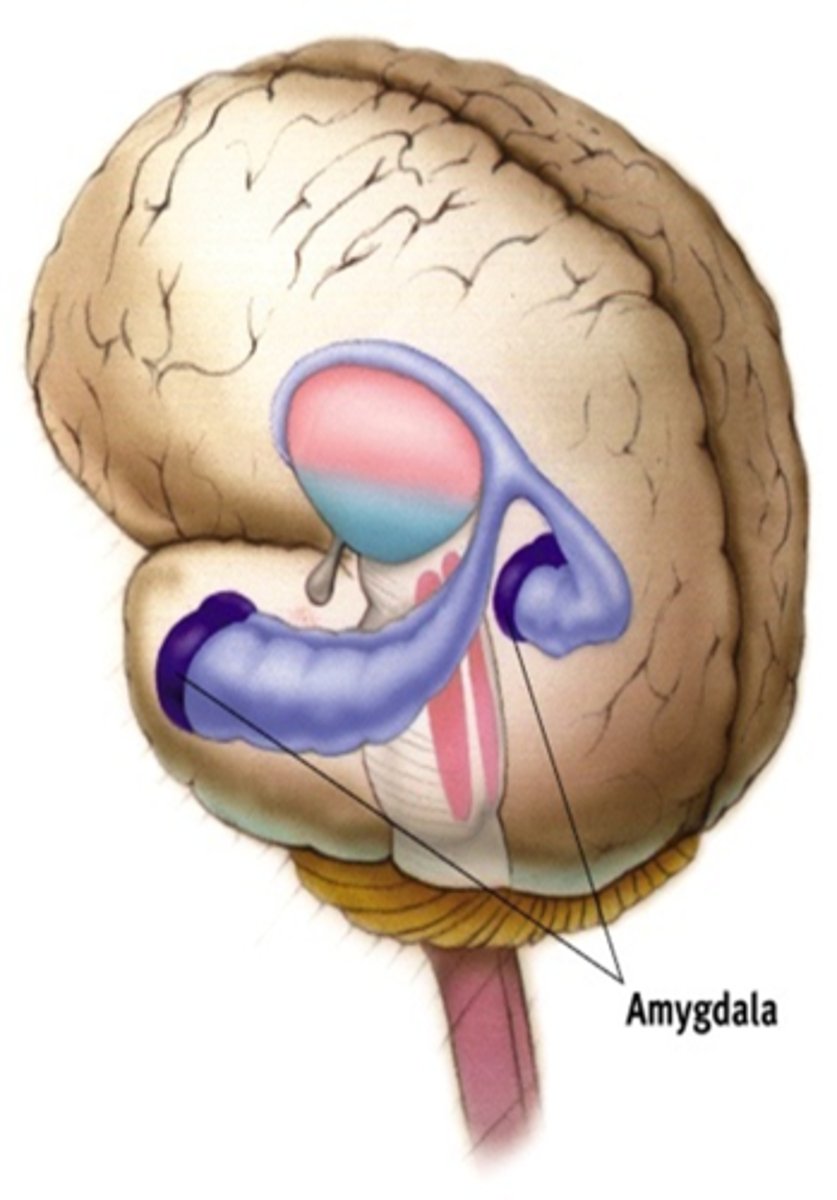
// The Impact of PTSD on the brain (Van Der Kolk, 2003)
•Increased activity of the amygdala, right hemisphere, insula and medial temporal lobe
•Decreased activation of Prefrontal cortex
•Decreased activation of the hippocampus (lack of integration of the traumatic event)
•Decreased activation of Broc's area

// Edna Foa's theory of PTSD (1986, 1989, 1998)
•Edna Foa’s theory of PTSD (1986, 1989, 1998) focuses on a semantic fear network in long term memory that requires assimilation.
•Foa states that resolution of trauma occurs by integrating information in the fear network with existing memory structures. This assimilation process requires the activation of the fear network so that it becomes accessible for modification and also the availability of information that is incompatible with the fear network so that the overall memory structure can be modified.
// The Forgetting Curve (Ebbinghaus)
The Forgetting Curve (Ebbinghaus)

Decay theory // Theories of Forgetting
memory fades with time if they are not retrieved every now and then. Use it or lose it
Retroactive interference // Theories of Forgetting
recently learned material interferes with remembering a similar previously stored material. (a waiter taking guest orders)
Proactive interference // Theories of Forgetting
previously learned material interferes with remembering a similar new material. (Old phone number vs. new phone number)
// Theories of Forgetting
•Lack of attention during Storage (encoding failure)
•Decay theory: memory fades with time if they are not retrieved every now and then. Use it or lose it
•Retroactive interference: recently learned material interferes with remembering a similar previously stored material. (a waiter taking guest orders)
•Proactive interference: previously learned material interferes with remembering a similar new material. (Old phone number vs. new phone number)
// Amnesia
•Can be caused by Electro Convulsive Therapy, Hypothermia, Concussion, Infection, Tumor, Lesion
•Anterograde Amnesia: the inability to store new long-term memories that occurs after an amnesia inducing event.
•Retrograde amnesia: the loss of memory for events that occurred prior to the amnesia inducing event.

Retrograde amnesia// Amnesia
the loss of memory for events that occurred prior to the amnesia inducing event.
// Damage to other regions of the brain that disrupt memory
•Damage to the Amygdala causes impairments in fear conditioning or startle responses.
•Damage to the Cerebellum causes distruption of eye-blink conditioning,
while damage to the Striatum (Caudate nucleus, Putamen) causes a disruption of habit learning such as procedural memories.
// Korsakoff's syndrome
•Anterograde amnesia caused by thiamine deficiency (==often associated with alcoholism==)
•Damage to the dorsomedial nucleus of thalamus and mammillary bodies
•Intact implicit, procedural memory and short term/working memory
•Inability to form new explicit memories

// Papez Circuit (James Papez, 1937)
•A series of interconnected brain regions that have key roles in the formation of explicit memories
•Hippocampus, Parahippocampal gyrus, Mammilary body, Anterior Nucleus of the Thalamus, Fornix and Cingulate Gyrus
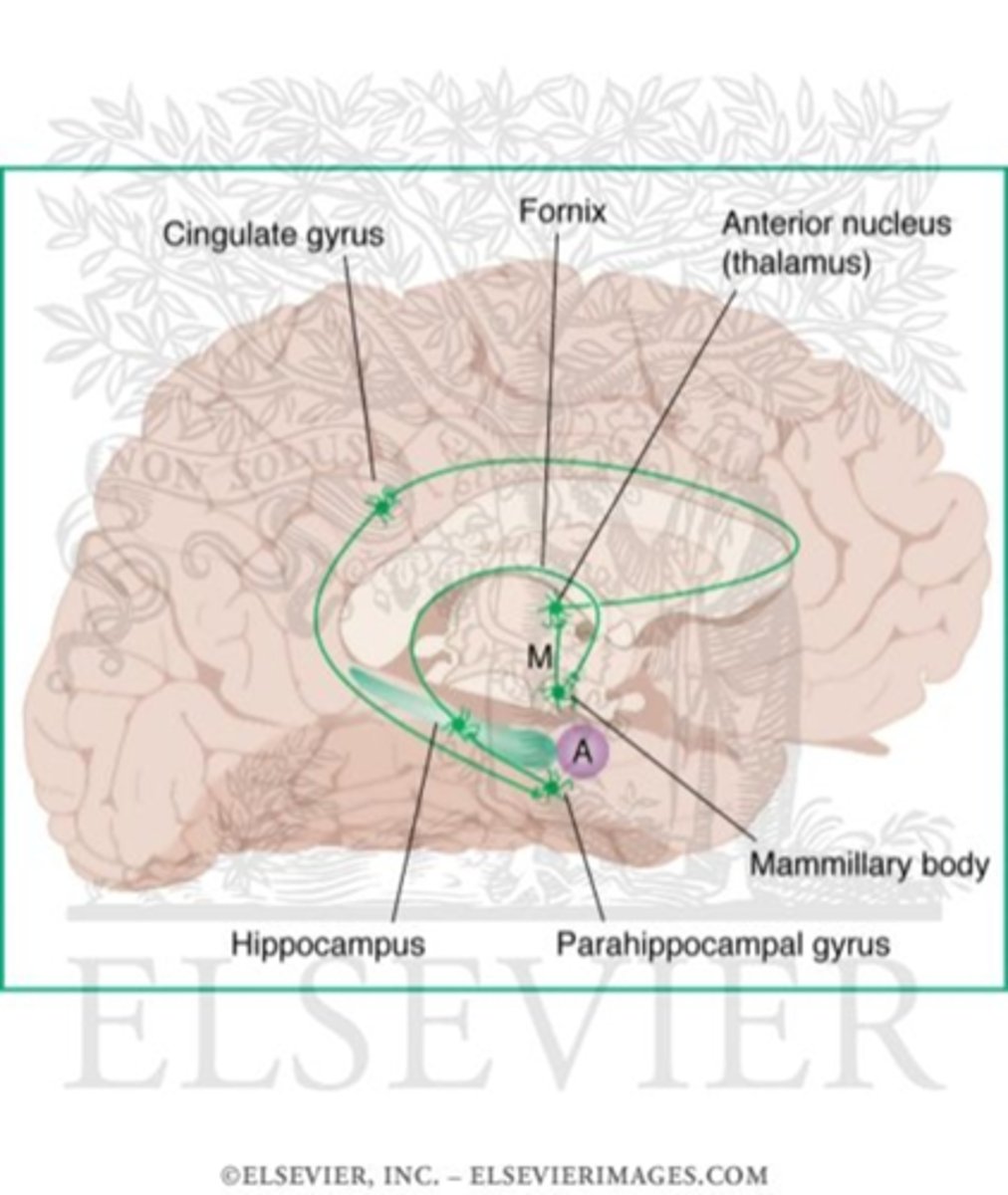
// "disruption of these pathways leads to disruption of memory and learning"
•Acetylcholine pathways starting from the basal forebrain nuclei regulate the activity of the hippocampus. (disruption of these pathways leads to disruption of memory and learning)

// Alzheimer's disease
•Alzheimer’s disease: Symptoms include widespread disturbances in working, semantic, episodic and procedural memory in individuals aged 65 and above. Other symptoms include confusion, irritability, aggression, mood swings, language breakdown, and the general social withdrawal of the patient as his or her senses decline.
•The average life expectancy following diagnosis is approximately seven years. Fewer than 3% of patients live more than fourteen years.
Alzheimer’s disease // Alzheimer’s disease
Symptoms include widespread disturbances in working, semantic, episodic and procedural memory in individuals aged 65 and above. Other symptoms include confusion, irritability, aggression, mood swings, language breakdown, and the general social withdrawal of the patient as his or her senses decline.
// Predementia stage of Alzheimer’s Disease
•The most noticeable symptom is memory loss, which involves a difficulty to remember recently learned facts and an inability to acquire new information.
•Slight problems with the executive functions of attentiveness, planning, mental flexibility, and abstract thinking or with impairments in semantic memory and concept relationships can also be symptomatic of the early stages of Alzheimer's Disease.
•Apathy can be begun to be observed at this stage.
// Early dementia stage of Alzheimer’s Disease
•Language problems mainly involve a shrinking vocabulary and decreased word fluency, which lead to a general limitations of oral and written language. In contrast, people are usually capable of adequately communicating basic ideas.
•While performing fine motor tasks such as writing, drawing or dressing, certain movement coordination difficulties may be present, which may appear as clumsiness.
// Moderate dementia stage of Alzheimer’s Disease
•Reading and writing skills are progressively lost.
•Complex motor sequences become less coordinated as time passes, reducing the ability to perform most normal daily living activities.
•Short-term memory problems worsen and Long-term memory problems occur
•The person may not recognize close relatives.
•Wandering, irritability, crying, outbursts of unprovoked aggression or resistance to care-giving occur.
•Approximately 30% of the patients also develop illusionary misidentifications and other delusional symptoms.
•Lack of control over urination can develop.
// Advanced dementia stage of Alzheimer’s Disease
•The patient is completely dependent upon caregivers.
•Language is reduced to simple phrases or even single words, eventually leading to complete loss of speech. (They can still receive and return emotional signals via facial expressions.)
•Patients will ultimately not be able to perform even the most simple tasks without assistance.
•Muscle mass and mobility will deteriorate to the point where they are bedridden, and they will also lose the ability to feed themselves.
•Death occurs from some external factor such as pressure ulcers or pneumonia, and not from the disease itself.
// Causes of Alzheimer's Disease
•Causes of Alzheimer’s Disease
•Cytoskeletal (within the cell structure) abnormalities
•Formation of Neurofibrillary tangles.
•The tangles disrupt intracellular transport of proteins causing cell death.
•Neurofibrillary tangles are left behind.
// Components of Language
•Phonology: studying the production and perception of sounds found for a particular language.
•Prosody: rhythm and stress (emphasis found in speech // "statement and question; with tone"
•Semantics: studying the meaning of words.
•Syntax (Grammar): studying the structure and rules of constructing well formed sentences // "different rules"
•Discourse comprehension: understanding the context of how sentences are related to each other and their relation to semantic memory. // "something has to pull together"; "making individual sentences cohesive"
Phonology // Components of Language
studying the production and perception of sounds found for a particular language.
Prosody // Components of Language
rhythm and stress (emphasis found in speech // "statement and question; with tone"
Semantics // Components of Language
studying the meaning of words.
Syntax (Grammar) // Components of Language
studying the structure and rules of constructing well formed sentences // "different rules"
Discourse comprehension // Components of Language
understanding the context of how sentences are related to each other and their relation to semantic memory. // "something has to pull together"; "making individual sentences cohesive"
// The Competition model (MacWhinney & Bates, 1989, MacWhinney, 1987)
•A theoretical framework describing cross-linguistic performance of different syntactic and semantic features.
•Different languages use different sets of syntactic and semantic features that guide the sentence comprehension.
•Cue validity refers to the reliability of a given syntactic or semantic form in guiding comprehension.
•Children can become sensitive to these syntactic and semantic cues early in language acquisition.
// syntax = grammatical; semantics = meaning